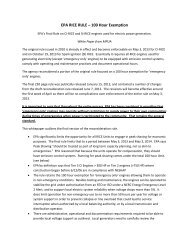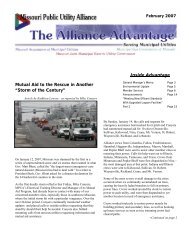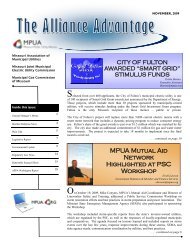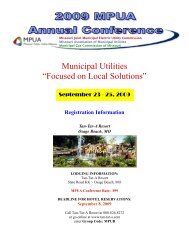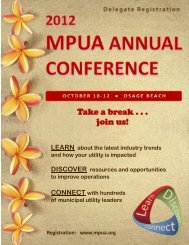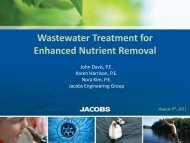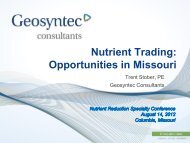cost/benefit study of the impacts of potential nutrient controls for ...
cost/benefit study of the impacts of potential nutrient controls for ...
cost/benefit study of the impacts of potential nutrient controls for ...
Create successful ePaper yourself
Turn your PDF publications into a flip-book with our unique Google optimized e-Paper software.
COST/BENEFIT STUDY OF THE IMPACTS OF<br />
POTENTIAL NUTRIENT CONTROLS FOR COLORADO<br />
POINT SOURCE DISCHARGES<br />
August 10, 2011
Acknowledgements<br />
• Michael Brod, Colorado Water Resources and Power<br />
Development Authority (CWRPDA) (funding agency)<br />
• David Akers, Dick Parachini, Colorado Department <strong>of</strong> Public<br />
Health & Environment (CDPHE) – Water Quality Division<br />
• David Holm, Consultant to CDPHE<br />
• Project Team<br />
– Becky Dunavant, Jacqui Wesley, Sarah Stewart, Susan Morea -<br />
CDM<br />
– Ed Harvey, Susan Walker, Melinda Ogle – Harvey Economics<br />
– Tim Moore, Risk Sciences<br />
Colorado Nutrient Cost/Benefit Study<br />
2
Presentation Outline<br />
• Overview<br />
• Colorado Approach to Nutrient Control<br />
• Cost-Benefit Study Objectives<br />
• Methodology Framework<br />
• Wastewater Costs<br />
• Water Supply Benefits<br />
• Environmental Benefits<br />
• Example Preliminary Results<br />
• Next Steps<br />
Colorado Nutrient Cost/Benefit Study<br />
3
Cost-Benefit Study Purpose<br />
• In<strong>for</strong>m <strong>the</strong> Colorado Water Quality Control Commission and<br />
State Agencies (CDPHE and CWRPDA) regarding implications<br />
<strong>of</strong> proposed regulations <strong>for</strong> controlling <strong>the</strong> discharge <strong>of</strong><br />
<strong>nutrient</strong>s that rely largely on a technology-based control<br />
regulation that would establish effluent limits <strong>for</strong> most<br />
municipal and some industrial wastewater treatment<br />
facilities.<br />
Colorado Nutrient Cost/Benefit Study<br />
4
Cost-Benefit Study Objectives<br />
• Determine statewide aggregate POTW <strong>cost</strong>s resulting from<br />
<strong>the</strong> <strong>potential</strong> implementation <strong>of</strong> a range <strong>of</strong> statewide<br />
regulations to address <strong>nutrient</strong>s (based on evaluation <strong>of</strong><br />
three tiers <strong>of</strong> <strong>potential</strong> effluent quality <strong>for</strong> Total Phosphorus<br />
[TP] and Total Inorganic Nitrogen [TIN]);<br />
• Determine statewide <strong>cost</strong>s associated with implementation<br />
<strong>of</strong> stormwater monitoring requirements;<br />
• Determine <strong>the</strong> environmental <strong>benefit</strong>s <strong>of</strong> implementation <strong>of</strong><br />
proposed <strong>nutrient</strong> regulations (<strong>for</strong> three effluent tiers); and<br />
• Determine <strong>the</strong> <strong>benefit</strong> to drinking water quality and reduced<br />
treatment <strong>cost</strong>s.<br />
Colorado Nutrient Cost/Benefit Study<br />
5
COLORADO APPROACH TO<br />
NUTRIENT CONTROL
Regulatory Approach<br />
• CDPHE proposes to adopt two regulations to establish<br />
<strong>nutrient</strong> <strong>controls</strong><br />
– Regulation 31 – Establishes interim instream TIN, TP, and<br />
chlorophyll a (Chl a) values <strong>for</strong> streams, rivers, lakes and<br />
reservoirs<br />
• Interim values will not be used <strong>for</strong> adoption <strong>of</strong> water quality<br />
standards except in specific circumstances (e.g., concerns<br />
regarding water supply in specific lakes and reservoirs) prior to<br />
May 2017 <strong>for</strong> TP and Chl a and May 2022 <strong>for</strong> TIN.<br />
– Regulation 85 – Establishes <strong>nutrient</strong> control requirements <strong>for</strong><br />
POTWs that vary depending on facility size and type and<br />
whe<strong>the</strong>r <strong>the</strong> facility is existing or new as <strong>of</strong> May 2012<br />
Colorado Nutrient Cost/Benefit Study<br />
7
Proposed Regulation 31 – Total Phosphorus<br />
Interim Total Phosphorus Values<br />
Lakes and Reservoirs, cold, >25 acres 20 µg/L 1<br />
Lakes and Reservoirs, warm > 25 acres 80 µg/L 1<br />
Lakes and Reservoirs,
Proposed Regulation 31 – Total Nitrogen<br />
Interim Total Nitrogen Values<br />
Lakes and Reservoirs, cold, >25 acres 410 µg/L 1<br />
Lakes and Reservoirs, warm, > 25 acres 850 µg/L 1<br />
Lakes and Reservoirs,
Proposed Regulation 85 - Overview<br />
• Existing Domestic Wastewater Treatment Facilities, as <strong>of</strong><br />
May 30, 2012<br />
– Small or disadvantaged communities, following are exempt:<br />
• Any facility with a design capacity <strong>of</strong> ≤ 1.0 MGD that uses waste<br />
stabilization pond technology as its means <strong>of</strong> treating<br />
wastewater<br />
• Any facility owned by a disadvantaged community<br />
• Any facility with a design capacity <strong>of</strong> ≤ 0.1 MGD<br />
– Facilities subject to a Watershed Protection Control Regulation<br />
are exempt until May 31, 2022<br />
– All o<strong>the</strong>r existing facilities – required to comply with Tier 1<br />
numeric effluent limits<br />
Colorado Nutrient Cost/Benefit Study<br />
10
Proposed Regulation 85 - Overview<br />
• New Facilities<br />
– Comply with Tier 2 numeric effluent limits<br />
• Non-Domestic Facilities<br />
– If discharging prior to May 30, 2013, comply with Tier 1<br />
numeric effluents, where <strong>the</strong> State has determined that <strong>the</strong><br />
effluent quality will exceed <strong>the</strong> Tier 1 limits<br />
– If discharging after May 30, 2013, comply with Tier 2, where<br />
<strong>the</strong> State has determined that <strong>the</strong> effluent quality will exceed<br />
<strong>the</strong> Tier 2 limits<br />
• Additional implementation requirements within regulation;<br />
review at: www.cwqf.org/Workgroups/Workgroup.htm<br />
(click on “<strong>nutrient</strong> workgroup”)<br />
Colorado Nutrient Cost/Benefit Study<br />
11
Cost-Benefit Analysis <strong>of</strong> Effluent Tiers<br />
• Regulation 85 includes Tiers 1 and 2; additional analysis <strong>for</strong><br />
Tier 3 is included in <strong>the</strong> <strong>cost</strong>-<strong>benefit</strong> <strong>study</strong><br />
Nutrient<br />
Tier 1<br />
Tier 2<br />
Tier 1<br />
Tier 2<br />
Tier 3 –<br />
Semi-<br />
Semi-<br />
Annual<br />
Annual<br />
Quarterly<br />
Median 1 Annual<br />
Median 2 Median 1 Annual<br />
Median 2 Average<br />
Total Inorganic<br />
Nitrogen (TIN)<br />
(mg/L)<br />
Total<br />
Phosphorus<br />
(mg/L)<br />
10.0 15.0 7.0 10.0<br />
1.0 1.25 0.7 1.0<br />
0.4 (Cold)<br />
2.0 (Warm)<br />
0.11 (Cold)<br />
0.16 (Warm)<br />
1<br />
Rolling annual median, based on previous 12 months <strong>of</strong> data<br />
2<br />
Six-month median value<br />
Colorado Nutrient Cost/Benefit Study<br />
12
COST-BENEFIT METHODOLOGY FRAMEWORK
Methodology Framework - Overview<br />
Wastewater Costs<br />
• Categorize facility size/type<br />
• “Typical “ upgrades to meet effluent tiers<br />
• Capital and O&M <strong>cost</strong>s<br />
Subdivide <strong>the</strong> State<br />
into Manageable<br />
Units (MU)<br />
MU-Specific Analyses<br />
• Expected water quality<br />
Improvements by Tier<br />
• Pilot test methodology in 2 MUs<br />
• Ramp up to all MUs<br />
Cost-Benefit Analysis<br />
• MU-specific <strong>benefit</strong><strong>cost</strong><br />
ratios<br />
• Aggregate data by<br />
Basin and State<br />
Potential Benefits<br />
• Public Water Supply (avoided <strong>cost</strong>s by Tier)<br />
• Environmental (active, passive, intrinsic by Tier)<br />
Colorado Nutrient Cost/Benefit Study<br />
14
27 Proposed Manageable Units<br />
Colorado Nutrient Cost/Benefit Study<br />
16<br />
DRAFT
Platte Basin MUs<br />
DRAFT<br />
Colorado Nutrient Cost/Benefit Study<br />
17
Platte Basin MUs – Close-up <strong>of</strong> Front Range<br />
DRAFT<br />
Colorado Nutrient Cost/Benefit Study<br />
18
Gunnison Basin MUs<br />
DRAFT<br />
Colorado Nutrient Cost/Benefit Study<br />
19
Pilot Test Methodology<br />
• Two Manageable Units selected to pilot test methodology<br />
– St. Vrain subwatershed <strong>of</strong> <strong>the</strong> Platte Basin (north <strong>of</strong> Denver,<br />
includes Cities <strong>of</strong> Boulder and Longmont)<br />
– Eagle River subwatershed (includes Cities <strong>of</strong> Vail and Eagle)<br />
• Pilot test is key to overall project execution<br />
– Opportunity to “test drive” methodology<br />
– Allows stakeholders to provide input be<strong>for</strong>e statewide<br />
application<br />
– Methods refined based on stakeholder input<br />
• Cost-<strong>benefit</strong> methodology applied to all MUs after<br />
methodology affirmed<br />
Colorado Nutrient Cost/Benefit Study<br />
20
Manageable Unit Analysis Based on Expected<br />
Water Quality Improvement<br />
• Streams & Rivers<br />
– Calculated instream median TP and TIN based on existing data<br />
– POTW discharges based on a 75% design capacity flow<br />
– Assumed effluent concentrations <strong>of</strong> 4.5 mg/L <strong>for</strong> TP and 25<br />
mg/L <strong>for</strong> TIN unless POTW-specific data available<br />
– Background <strong>nutrient</strong> concentrations (o<strong>the</strong>r than POTWs) based<br />
on land use type and associated event mean concentrations<br />
• Lakes & Reservoirs<br />
– Similar assumptions as provided above<br />
– Water quality modeled using Continuously Stirred Tank<br />
Reactor calculation, except where existing model available<br />
– Incorporated reservoir-specific characteristics, as appropriate<br />
Colorado Nutrient Cost/Benefit Study<br />
21
WASTEWATER COSTS<br />
23
Approach to Wastewater Cost Estimates<br />
Ga<strong>the</strong>r facility data<br />
from state; conduct<br />
surveys with<br />
dischargers<br />
Develop “Typical”<br />
plants <strong>for</strong> MUs<br />
Develop process unit<br />
sizes and flow diagram<br />
<strong>for</strong> each “typical” plant<br />
Determine O & M<br />
<strong>impacts</strong> and <strong>cost</strong>s <strong>for</strong><br />
each MU<br />
Calculate capital <strong>cost</strong>s<br />
<strong>for</strong> MUs from models,<br />
reports, surveys,<br />
contractors, vendors<br />
Determine<br />
improvements required<br />
<strong>for</strong> each “typical” base<br />
plant <strong>for</strong> each effluent<br />
tier<br />
Confirm <strong>cost</strong>s with<br />
existing reports, <strong>cost</strong><br />
estimates, studies<br />
Calculate total present<br />
worth <strong>for</strong> each MU<br />
based on capital and<br />
annual O & M <strong>cost</strong>s<br />
Colorado Nutrient Cost/Benefit Study<br />
24
Determine Improvements <strong>for</strong> Each Tier and<br />
Category<br />
Category/Description<br />
1 Suspended Growth<br />
Action<br />
Upgrade <strong>for</strong> each Tier<br />
Filters satisfy 75% <strong>of</strong> Tier 3 requirement<br />
2 1 st Generation Fixed Film Replace with mechanical plant<br />
3 2 nd Generation Fixed Film<br />
Upgrade <strong>for</strong> each Tier<br />
Portions <strong>of</strong> <strong>the</strong> plant can be used in upgrade<br />
4 Lagoon Replace with mechanical plant<br />
5 Sequencing Batch Reactor Replace with mechanical plant<br />
6 Oxidation Ditch<br />
Upgrade <strong>for</strong> each Tier<br />
Portions <strong>of</strong> <strong>the</strong> plant can be used in upgrade<br />
Colorado Nutrient Cost/Benefit Study<br />
25
Wastewater Costs - Overview<br />
Cost Area<br />
Capital<br />
Operation &<br />
Maintenance<br />
Key Cost Elements*<br />
• Categorize facilities by general treatment type (6 categories) and<br />
permitted capacity<br />
• Develop “typical” <strong>cost</strong>s associated with meeting effluent quality tier and<br />
upgrading existing facility types<br />
• Incorporate allowances (percent <strong>of</strong> capital <strong>cost</strong>, varies by facility size and<br />
treatment tier)<br />
• Hydraulics (% <strong>of</strong> existing<br />
average daily flow)<br />
• Site Work (5-10%)<br />
• Yard Piping (5-10%)<br />
• Electrical (5-10%)<br />
• Contingency (30%) and Engineering (25%)<br />
• Instr. & Controls (5 – 15%)<br />
• Misc. Repair (1%)<br />
• Flow Maintenance (1 – 3%)<br />
• Land Acquisition (2%)<br />
• Labor (additional labor/tier at fully loaded rate and annual training <strong>cost</strong>s)<br />
• Chemical (tier dependent)<br />
• Power <strong>cost</strong>s/kwh<br />
* Sources: EPA, unit <strong>cost</strong>s, literature, CDM’s bid database, POTWs<br />
Colorado Nutrient Cost/Benefit Study<br />
26
Facility Categorization – St. Vrain MU<br />
Flow Bin<br />
(MGD)<br />
Existing Treatment Process<br />
Facility<br />
Category<br />
No. <strong>of</strong><br />
Facilities<br />
Upgrade<br />
AS<br />
Full<br />
conversion<br />
to AS<br />
0.5 to 1 Aerated Lagoon 4 1 X<br />
> 1 to 3<br />
Activated Sludge 1 2 X<br />
• MBBR or IFAS with Filters<br />
• Activated Sludge with<br />
Nitrifying Trickling Filters<br />
3 2 X<br />
> 3 to 5 Activated Sludge with Filters 1 1 X<br />
> 10<br />
Activated Sludge 1 1 X<br />
Activated Sludge with Nitrifying<br />
Trickling Filters<br />
1 1 X<br />
Colorado Nutrient Cost/Benefit Study<br />
27
Develop Capital Costs by Flow Bin, Treatment<br />
Category – Example Tier 1 Summary<br />
Estimated Cost/Gallon and Capital Costs ( based on permitted capacity, excluding land<br />
acquisition and engineering <strong>cost</strong>s)<br />
Flow Bin<br />
(MGD)<br />
Cat. 1<br />
Unit Cost<br />
0 – 0.5 > 0.5 – 1.0 > 1.0 – 3.0 > 3.0 – 5.0 > 10.0<br />
$ 2.72 $ 1.46 $ 1.65 $ 1.51<br />
Subtotal $ $4.4M $13.3M $5.6M $81.8M<br />
Cat. 3<br />
Unit Cost<br />
Subtotal $<br />
Cat. 4<br />
Unit Cost<br />
$ 6.92 $ 5.58<br />
Subtotal $ $1.6M $5.5M<br />
Cat. 5<br />
Unit Cost<br />
Subtotal $<br />
$ 6.92<br />
$3.5M<br />
$ 2.83<br />
$11.3M<br />
Colorado Nutrient Cost/Benefit Study<br />
28
Develop O & M Costs by Flow Bin, Treatment<br />
Category – Example Tier 1 Summary<br />
Estimated Cost/Gallon and O & M Costs (based on permitted capacity)<br />
Flow Bin (MGD) 0 – 0.5 > 0.5 – 1.0 > 1.0 – 3.0 > 3.0 – 5.0 > 10.0<br />
Cat. 1 - Unit Cost Labor $ 0.22 $ 0.07 $ 0.07 $ 0.04<br />
Cat. 1 - Unit Cost Non-Labor $ 0.04 $ 0.04 $ 0.10 $ 0.10<br />
Subtotal $ $0.4M $0.9M $0.5M $6.2M<br />
Cat. 3 - Unit Cost Labor $ 0.07<br />
Cat. 3 - Unit Cost Non-Labor $ 0.04<br />
Subtotal $<br />
Cat. 4 - Unit Cost Labor $ 0.37 $ 0.37<br />
Cat. 4 - Unit Cost Non-Labor $ 0.07 $ 0.07<br />
Subtotal $ $0.1M $0.4M<br />
Cat. 5 - Unit Cost Labor $ 0.22<br />
Cat. 5 - Unit Cost Non-Labor $ 0.04<br />
Subtotal $ $0.1M<br />
Colorado Nutrient Cost/Benefit Study<br />
$0.4M<br />
29
WATER SUPPLY BENEFITS
Water Supply Nitrate/Nitrite Benefits<br />
• A negligible O&M <strong>cost</strong> savings may results from decreased<br />
ammonia loading<br />
• For pilot MUs, we have concluded that <strong>the</strong>re is no need to<br />
include public water supply <strong>cost</strong>s <strong>for</strong> removal <strong>of</strong> nitrogen<br />
since existing water quality is well below primary drinking<br />
water MCLs; this will be evaluated <strong>for</strong> each MU<br />
• Potential <strong>for</strong> chloramine <strong>for</strong>mation and resulting nitrogenbased<br />
Disinfection By-Products (DBPs) being evaluated<br />
qualitatively<br />
Colorado Nutrient Cost/Benefit Study<br />
31
Water Supply Benefits – Total Phosphorus<br />
• There are no Primary Drinking Water MCLs; concerns linked<br />
to <strong>the</strong> <strong>for</strong>mation <strong>of</strong> DBPs and taste and odor concerns<br />
• Difficult to directly relate TP to DBP <strong>for</strong>mation <strong>potential</strong>;<br />
instead relying on compliance with Stage 1 and Stage 2<br />
D/DBP Rule<br />
• Stage 1 compliance has not been identified as a concern<br />
with any water treatment facilities<br />
• Potential Stage 2 compliance concerns identified <strong>for</strong> a<br />
number <strong>of</strong> facilities – will be looking at <strong>potential</strong> avoided<br />
<strong>cost</strong>s (quantitative or qualitative) associated with improved<br />
instream TP concentrations<br />
Colorado Nutrient Cost/Benefit Study<br />
32
ENVIRONMENTAL BENEFITS<br />
33
Primary Elements <strong>of</strong> <strong>the</strong> Cost-Benefit Analysis<br />
POTW COSTS<br />
BENEFITS (AVOIDED COSTS)<br />
Upgrades, Operating<br />
Cost <strong>of</strong> Affected Point<br />
Source Dischargers<br />
Improved<br />
Domestic Water<br />
Supply Quality<br />
ACTIVE<br />
i.e., Recreation<br />
PASSIVE<br />
i.e., Aquatic Life<br />
INTRINSIC<br />
i.e., Existence<br />
Values<br />
Estimate and Project<br />
Estimate and Project<br />
Determine Quantitative vs. Qualitative Benefits<br />
Discount to Present<br />
Value<br />
Discount to Present<br />
Value<br />
Estimate and Project<br />
Quantitative Benefits<br />
Discount to Present<br />
Value<br />
Characterize and<br />
Determine<br />
Magnitude <strong>of</strong><br />
Qualitative Benefits<br />
Compare Present Value Benefits and Costs<br />
Colorado Nutrient Cost/Benefit Study<br />
34
Benefit Definitions<br />
• Active Benefits: Based on direct use <strong>of</strong> a resource<br />
(i.e., fishing) or services provided by an ecosystem (i.e.,<br />
water <strong>for</strong> recreational opportunities, such as boating or<br />
swimming)<br />
• Passive Benefits: Derived from ecological functions that<br />
support active uses (i.e., habitat functions that support<br />
fishing)<br />
• Intrinsic Values: Knowledge that <strong>the</strong> resource or ecosystem<br />
exists in <strong>the</strong> world whe<strong>the</strong>r we use it or not<br />
Colorado Nutrient Cost/Benefit Study<br />
35
Quantification <strong>of</strong> Active Benefits<br />
USE ACTIVITY QUANTIFICATION<br />
Recreation<br />
Aquatic Life<br />
Recreation<br />
Stream, Lake Angling =<br />
Rafting, Kayaking,<br />
Boating<br />
Recreation Swimming =<br />
Recreation<br />
O<strong>the</strong>r<br />
Picnicking and Site-<br />
Seeing<br />
Agriculture Livestock =<br />
O<strong>the</strong>r Property Values =<br />
=<br />
=<br />
Increased angler days x expenditure value <strong>of</strong><br />
angler day<br />
Increased boating days x expenditure value<br />
<strong>of</strong> boating day<br />
Increased number <strong>of</strong> swimmers x<br />
expenditure value <strong>of</strong> swimmer day<br />
Increased site seers x expenditures per siteseer<br />
Increased weight gain <strong>of</strong> livestock x sales<br />
price per count<br />
Increased property value around reservoirs<br />
because <strong>of</strong> water clarity, etc.<br />
Where quantification is not possible, qualitative analyses are<br />
being considered<br />
Colorado Nutrient Cost/Benefit Study<br />
36
Quantification <strong>of</strong> Passive Benefits<br />
Colorado<br />
Elsewhere<br />
Willingness to Pay Studies<br />
(as closely applicable as possible)<br />
• Examples:<br />
• Habitat Protection<br />
• Endangered Species<br />
• Species Diversity<br />
• Factors:<br />
• Time period<br />
• Geography<br />
• Weighted average<br />
household income<br />
Adjusted <strong>for</strong> Revealed Payments<br />
Colorado Nutrient Cost/Benefit Study<br />
38
Environmental Benefits<br />
• Environmental <strong>benefit</strong> calculations depend on an estimate <strong>of</strong><br />
expected water quality improvement<br />
• Active Benefits<br />
– Percent change in water quality equated to percent change in<br />
visitor days<br />
– Change in visitor days <strong>for</strong> various recreational activities used as<br />
primary means to quantify active <strong>benefit</strong>s<br />
• Passive/Intrinsic Benefits<br />
– Based on “Willingness-to-Pay” (WTP) calculation methods and<br />
factors such hypo<strong>the</strong>tical WTP vs. actual WTP<br />
– Consideration <strong>of</strong> how to “re-distribute” <strong>benefit</strong>s to account <strong>for</strong><br />
people realizing <strong>benefit</strong>s outside <strong>of</strong> <strong>the</strong>ir immediate area<br />
Colorado Nutrient Cost/Benefit Study<br />
39
Environmental Benefits<br />
• Not all <strong>benefit</strong>s may be quantified; incorporating qualitative<br />
methods to account <strong>for</strong> such <strong>benefit</strong>s, e.g., using state nonconsumptive<br />
values assessment data<br />
– All major basins have completed a non-consumptive water<br />
needs assessment <strong>for</strong> environmental and recreational values<br />
– Stakeholder-led process; outcomes vary by basin<br />
– Willingness to pay adjusted to recognize <strong>the</strong> most highly<br />
valued stream reaches <strong>for</strong> recreational and environmental<br />
<strong>benefit</strong>s<br />
Colorado Nutrient Cost/Benefit Study<br />
40
PILOT STUDY RESULTS
Pilot Study Example – Preliminary Estimate <strong>of</strong><br />
Expected Water Quality Improvements (mg/L)<br />
Site 1<br />
Existing<br />
TP<br />
Tier 1<br />
TP<br />
Tier 2<br />
TP<br />
Tier 3<br />
TP<br />
Existing<br />
TIN<br />
Tier 1<br />
TIN<br />
Tier 2<br />
TIN<br />
Tier 3<br />
TIN<br />
PLT-01 0.60 0.32 0.30 0.25 3.50 1.92 1.49 0.54<br />
PLT -02 0.80 0.32 0.28 0.20 3.50 1.89 1.44 0.45<br />
PLT-03 2 0.50 0.26 0.24 0.20 3.20 1.76 1.35 0.46<br />
PLT-06 0.03 0.03 0.03 0.03 NA NA NA NA<br />
PLT-07 0.02 0.02 0.02 0.02 0.32 0.26 0.24 0.21<br />
PLT-08 0.02 0.02 0.02 0.02 0.33 0.20 0.17 0.12<br />
1<br />
– highest numbers are upstream locations<br />
2<br />
– below Boulder Creek subwatershed confluence; Boulder Creek data not shown<br />
Colorado Nutrient Cost/Benefit Study<br />
43
Pilot Study Examples – Preliminary Estimate <strong>of</strong><br />
Wastewater Costs in Two Manageable Units<br />
• Costs include land acquisition and engineering <strong>cost</strong>s<br />
Cost Type<br />
Effluent Tier<br />
Platte River Basin<br />
St. Vrain MU<br />
Colorado River Basin,<br />
Eagle River MU<br />
1 $157,574,000 $25,116,000<br />
Capital<br />
2 $403,127,000 $48,116,000<br />
3 $893,879,000 $172,347,000<br />
1 $4,683,000 $1,011,000<br />
O & M<br />
2 $9,125,000 $1,529,000<br />
3 $20,671,000 $4,855,000<br />
Colorado Nutrient Cost/Benefit Study<br />
44
Pilot Study Example – Preliminary Present Value<br />
Costs and Benefits ($ millions)<br />
Pilot MU<br />
Effluent<br />
Tier<br />
Total<br />
Costs<br />
Active<br />
Benefits<br />
Passive<br />
Benefits<br />
Total<br />
Benefits<br />
Benefit –<br />
Cost<br />
Ratio<br />
1 $214.6 $253.8 $69.4 $323.2 1 : 1.51<br />
Platte Basin<br />
(St. Vrain)<br />
2 $504.8 $299.6 $82.0 $381.6 1 : 0.76<br />
3 $1,126.1 $397.5 $108.8 $506.3 1 : 0.45<br />
Colorado<br />
Basin<br />
(Eagle River)<br />
1 $38.3 $26.6 $5.2 $31.8 1: 0.81<br />
2 $67.1 $30.9 $6.1 $37.0 1 : 0.55<br />
3 $230.6 $40.5 $8.0 $48.5 1 : 0.21<br />
Colorado Nutrient Cost/Benefit Study<br />
45
Pilot Study Example – Additional Refinements<br />
• Passive <strong>benefit</strong>s do not yet include factor that takes into<br />
account <strong>benefit</strong>s accrued from people who live outside<br />
<strong>the</strong> MU<br />
– Adjustment requires data <strong>for</strong> all MUs; impact will be higher<br />
<strong>benefit</strong> value<br />
• Potential fur<strong>the</strong>r refinement in wastewater <strong>cost</strong>s<br />
• Inclusion <strong>of</strong> avoided <strong>cost</strong>s <strong>for</strong> water treatment, if any<br />
• Qualitative findings, which will affect interpretation <strong>of</strong><br />
final <strong>benefit</strong>-<strong>cost</strong> ratios<br />
Colorado Nutrient Cost/Benefit Study<br />
46
NEXT STEPS
Next Step<br />
• Refine results in Pilot Study Manageable Units<br />
• Complete analyses in all Manageable Units<br />
• Develop Region-specific and Statewide Cost-Benefit Results<br />
• Prepare Study Report<br />
– Draft Report, September 2<br />
– Stakeholder Workshop, September 26<br />
– Final Report, October 19<br />
• Study Report to in<strong>for</strong>m rule-making process with public<br />
hearing on proposed regulations planned <strong>for</strong> March 2012<br />
Colorado Nutrient Cost/Benefit Study<br />
48
QUESTIONS


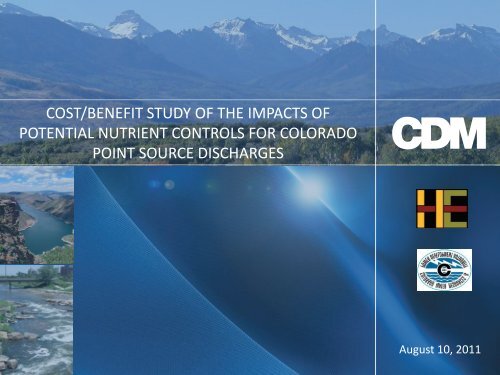
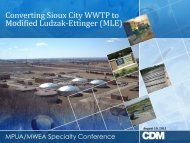
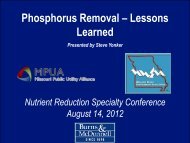

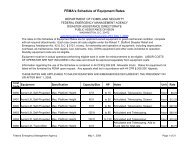
![VIA CERTIFIED MAIL (Return Receipt Requested) [DATE] Ms ...](https://img.yumpu.com/43063436/1/190x245/via-certified-mail-return-receipt-requested-date-ms-.jpg?quality=85)
